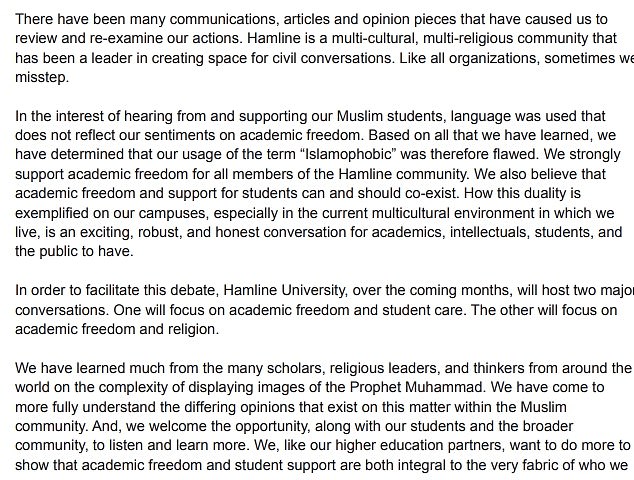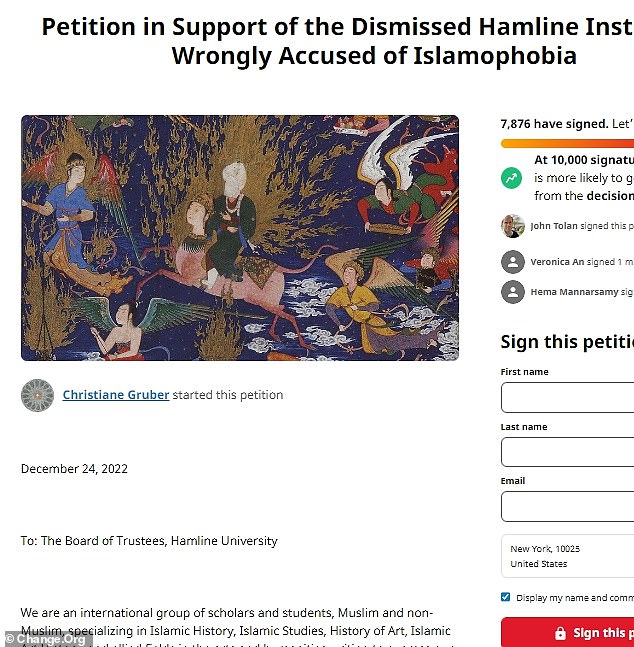‘Distressed’ Hamline University faculty ask school principal to RESIGN after sacking professor
>
Faculty leaders at a Minnesota university who fired an art history professor who showed depictions of the Prophet Muhammad in a course have overwhelmingly called for the resignation of the university’s president.
Hamline University faculty leaders said 71 of the 92 members who attended a meeting on Tuesday voted to ask President Fayneese Miller to resign immediately.
They say they lost faith in Miller because of his handling of an objection filed by a Muslim student who said viewing the artwork violated his religious beliefs.
The adjunct instructor who displayed the artwork, Erika López Prater, sued the private liberal arts school last week after it refused to renew her contract.

Faculty leaders at a Minnesota university that fired art history instructor Erika López Prater (pictured right), who showed depictions of the Prophet Muhammad in a course, have overwhelmingly called for the university president to Fayneese Miller (pictured left) resigns
“It became clear that the damage has been done and the repair that must be done, that new leadership is needed to move forward,” Jim Scheibel, chair of the Hamline University Faculty Council, told the Minneapolis Star Tribune.
The faculty objected to what they considered a violation of academic freedom.
“We are distressed that members of the administration have mishandled this issue and great damage has been done to the reputation of Minnesota’s oldest university,” the faculty council statement read.
He later went on to say, “As we no longer have faith in President Miller’s ability to lead the university, we ask that she immediately resign from the Hamline University Board of Trustees.”
After criticism from across the country, Miller admitted last week that he mishandled the episode, sparking a debate over the balance between academic freedom and respect for religion.
“Like all organizations, sometimes we make a false step,” he said in a joint statement with the school’s board chair. ‘In the interest of hearing and supporting our Muslim students, language was used that does not reflect our feelings on academic freedom. Based on all that we have learned, we have determined that our use of the term ‘Islamophobic’ was therefore misleading.’
A Hamline spokesperson told the St. Paul Pioneer Press that Miller and his team were discussing how to respond to the faculty vote.

Hamline University faculty leaders said 71 of the 92 members who attended a meeting on Tuesday voted to ask President Fayneese Miller to resign immediately.

The adjunct instructor who displayed the artwork, Erika López Prater, sued the private liberal arts school last week after it refused to renew her contract.


In October, Adjunct Professor Prater showed an image of the Prophet Muhammad to an online class as part of an art history class.
He warned the students who were virtually watching what he planned to do, giving them ample warning to look away from the image if they chose. In some, but not all, factions of Islam, it is forbidden to look at the image of the Prophet.
After class, Aram Wedatalla, a student who is also president of the university’s Muslim association, complained.
Wedatalla, the president of the university’s Muslim association that spearheaded the campaign to fire López Prater, chose to remain in line in class.
Afterwards, she and others were quick to complain to school officials that the image “blinded” her and made her feel left out.

Aram Wedatalla complained to the school, claiming that the image of the Prophet Muhammad had “shocked” her despite Professor Prater giving them multiple warnings that he intended to display it. It was an online class, during which she said students were given the opportunity to turn off their screens or look away.
‘I am 23 years old. I have never seen an image of the prophet,’ she said in a conference broadcast live on the CAIR-MN Facebook page, adding that she felt marginalized.
“It just breaks my heart to have to stand here and tell people that something is Islamophobic and that something really hurts all of us, not just me.”
Prater, who had been hired that semester for the first time and was due to return for the spring semester, was shown the door.
The university, bowing to the demands of the Muslim association, called the incident “Islamophobic.”
It caused an uproar among other Muslims and professors across the country, who said the school had stifled academic freedom.

In a statement, Hamline said it was a “misstep” to have labeled the lesson Islamophobic. It arrived two hours after the professor and her lawyers filed a lawsuit.

There was widespread support for the professor, with thousands of people signing a petition calling for her reinstatement.
A Muslim teacher accused the school of promoting an ‘extreme’ Islamist view held only by a small number of people.
The school initially stood its ground, saying it wanted to protect its Muslim students and make them feel heard.
On January 14, Professor Prater broke her silence in a discussion with Muslim scholars.
“In the way that I was framing Islamic art, I know that there are many practices within Islam, I know that historically there have been different attitudes about how the divine should be represented, but I know that inconsistency is constant within many religions, it’s not Islam specific.
“In my syllabus, I noted that I would show both representational and non-representational holy figures, such as the Prophet Muhammad, Jesus Christ, and Buddha.

CAIR, led by Nihad Awad, joined organizations including the American Civil Liberties Union ACLU, PEN America, The New York Times and Fox News on Friday in condemning the firing.

The statement did not mention how CAIR-MN’s Jaylani Hussein, the executive director of her Minnesota sect, earlier celebrated the firing. Hussein last week criticized the scholar’s decision to display the artwork as offensive and “an act of Islamophobia”.
“During my class, I alerted my students that I was about to display an image of the Prophet Muhammad, explaining my reasons for doing so, but also to demonstrate the rich diversity within the history of Islam.
‘Of course, in an art history classroom, images are the main source documents we use as evidence to learn about various cultures, thoughts and attitudes.
“I spent a couple of minutes explaining to the students, before showing the images. I told my students that if they didn’t feel comfortable interacting visually, they were free to do whatever made the most sense to them.
‘I tried to empower them to move away from the video part of the online classroom, or do whatever made the most sense to them.
I am not a mind reader. My discussion in my class was based on facts and on explaining the beginnings of Islam itself.

Wedatalla, the president of the university’s Muslim association that spearheaded the campaign to fire López Prater, chose to remain in line in class.

Wetdatalla spoke at a press conference on January 11 about the incident.
“All the images I used were very respectful, they were meant to be instructive and also referential in their original historical contexts.”
Professor Prater added that the student said her warnings “didn’t matter”.
‘She had some pretty strong feelings that she expressed to me. But one of them that maybe got to the heart of the matter was that she thought the warnings she had given the class didn’t even matter, because she believed that images of the Prophet Muhammad should never be shown point by point.
The instructor alleges in her lawsuit that Hamline subjected her to religious discrimination and defamation, and damaged her professional and personal reputation.
The American Association of University Professors, which is dedicated to academic freedom, has launched an investigation and is planning a campus visit next month.
While the leaders of some local Muslim groups have criticized Lopez Prater, the national office of the Council on American-Islamic Relations disputed claims that his actions were Islamophobic.
The group said professors who analyze images of the Prophet Muhammad for academic purposes are not the same as “Islamophobes who display such images to offend.”
